How do I set up QNAP MCP Assistant with Claude Desktop?Applicable Products
- QNAP NAS devices running QTS 5.2, QuTS hero h5.2, or later versions
- MCP Assistant
Introduction
This tutorial guides you through the process of setting up QNAP's MCP Assistant to work with Claude Desktop, which enables seamless integration between your QNAP NAS and Claude's AI capabilities. You can then use natural language commands to operate your NAS.
Prerequisites
Before your start, ensure that you have the following setup:
- QNAP NAS device with QTS 5.2, QuTS hero h5.2, or later versions
- Computer with internet connection (Windows or macOS; Claude Desktop is not available for Linux)
- Administrator access to your QNAP NAS
- Default MCP Assistant ports: 8442 and 8443
Procedure
- Install MCP Assistant (beta) from App Center.
- If your NAS runs QTS/QuTS hero 5.2.1 or later versions:
- Log in to your QNAP NAS.
- Go to the App Center.
- On the top-right corner, click

- Select Join the QNAP App Beta Program and click Apply.
- In the search bar, search for MCP Assistant.
- Click Install.
- If your NAS runs QTS/QuTS hero 5.2.0:
- Go to the webpage of App Center.
- Search for MCP Assistant.
- Click MCP Assistant from the search result.
- Select your NAS model.
- Download the installation file.
- Log in to your QNAP NAS.
- Go to App Center.
- On the right-top corner, click

- Select Install Manually.
- Click Browse and upload the installation file that you just downloaded from the QNAP website.
- Click Install.
- Open MCP Assistant.
- Locate the MCP Assistant from the Main Menu.
- Launch MCP Assistant.
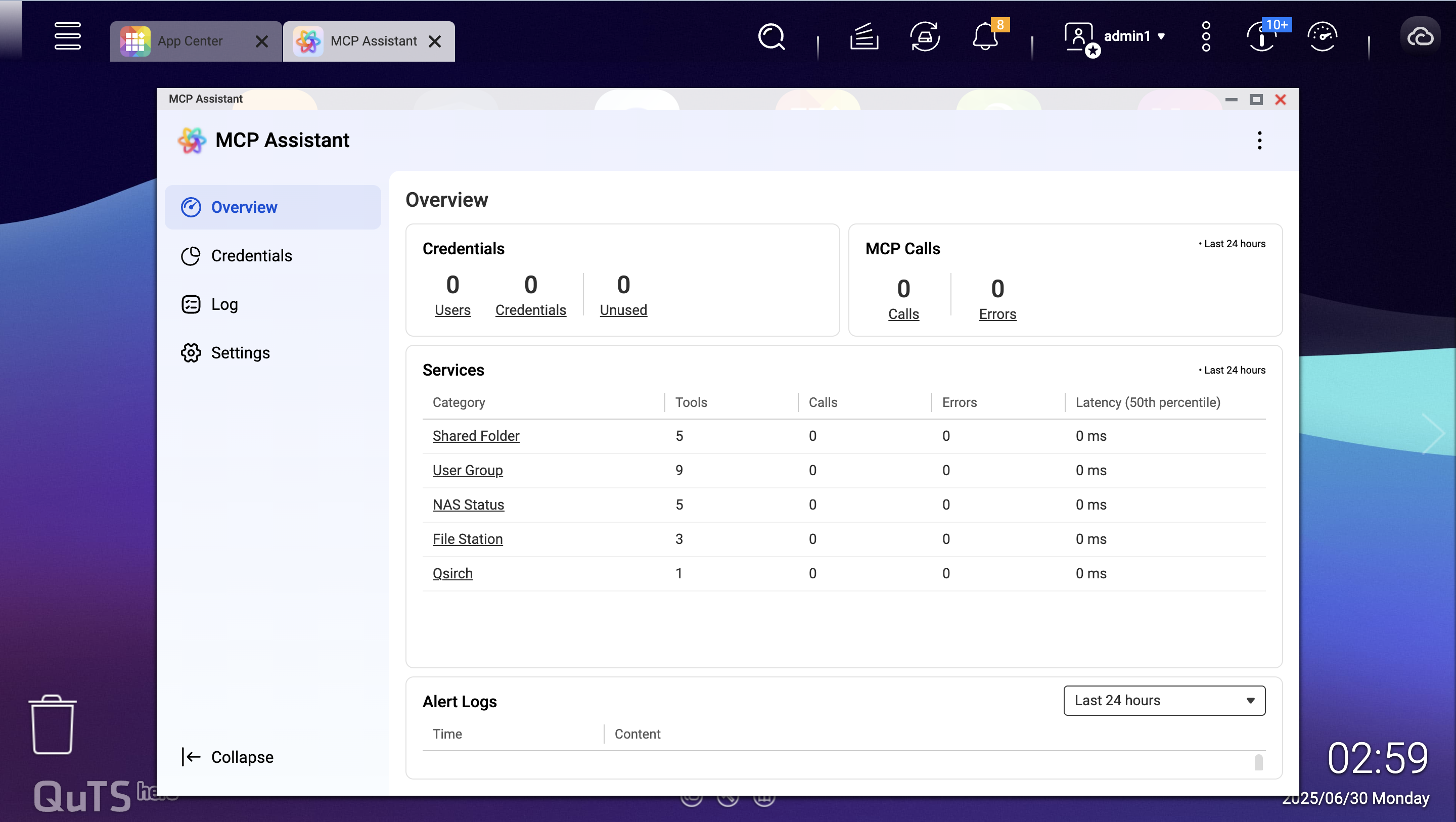
- Create credentials and download MCP Server.
- In the MCP Assistant, go to the Credentials tab.
- Click Create to generate a new key.
- Enter a descriptive name for the key, select the key type, and choose the user account to associate with this key.
Tip
By default, Read-only Mode is enabled. To grant more privileges to a trusted user, you may uncheck this option.
- Specify which MCP tools the user can access.
- Click Create to complete key creation.
- After the key is created, click the download arrow under Actions.
- The Download Key and MCP Server dialog will appear, which allows you to download the authentication key and MCP Server files to your computer.
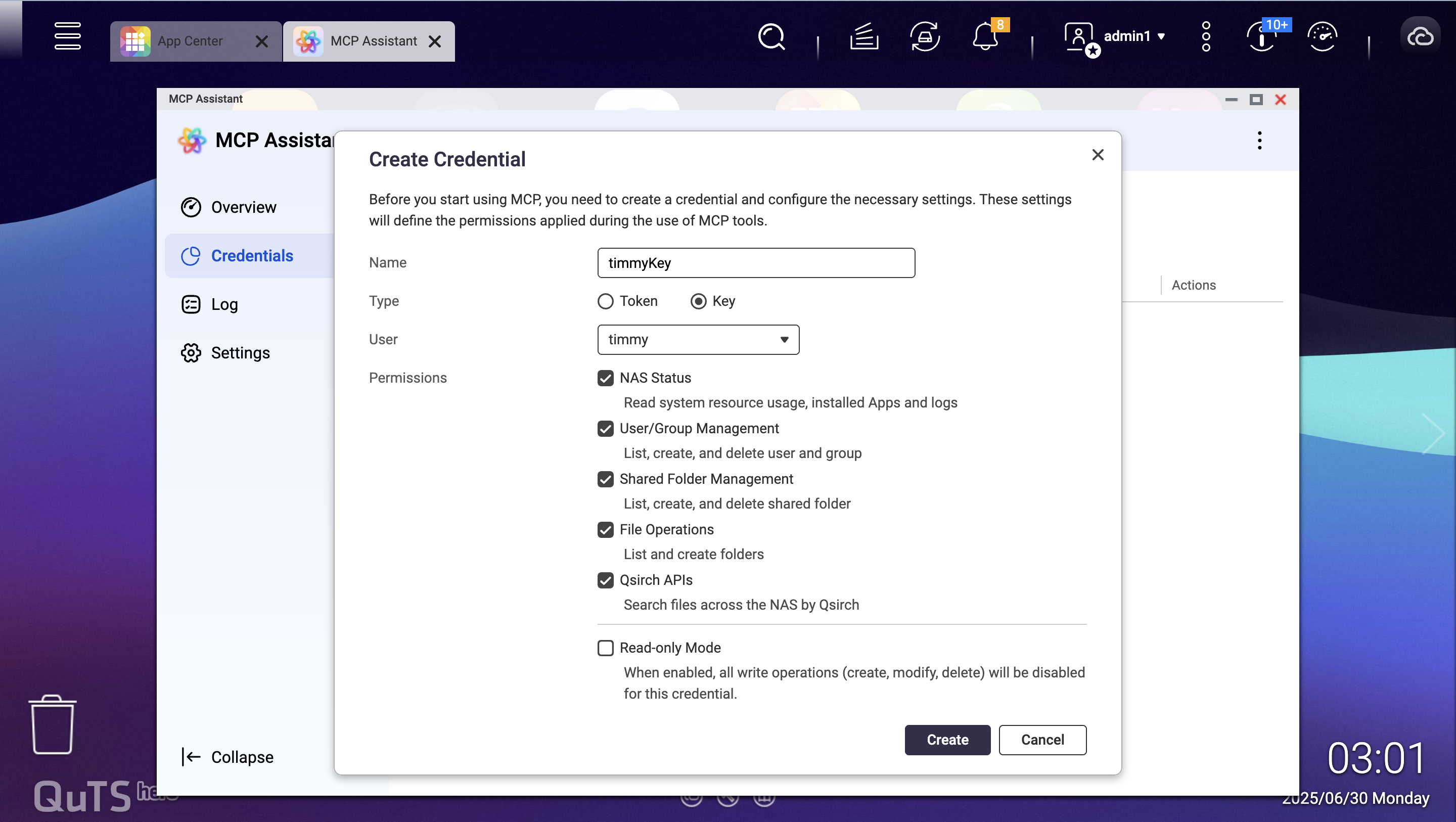
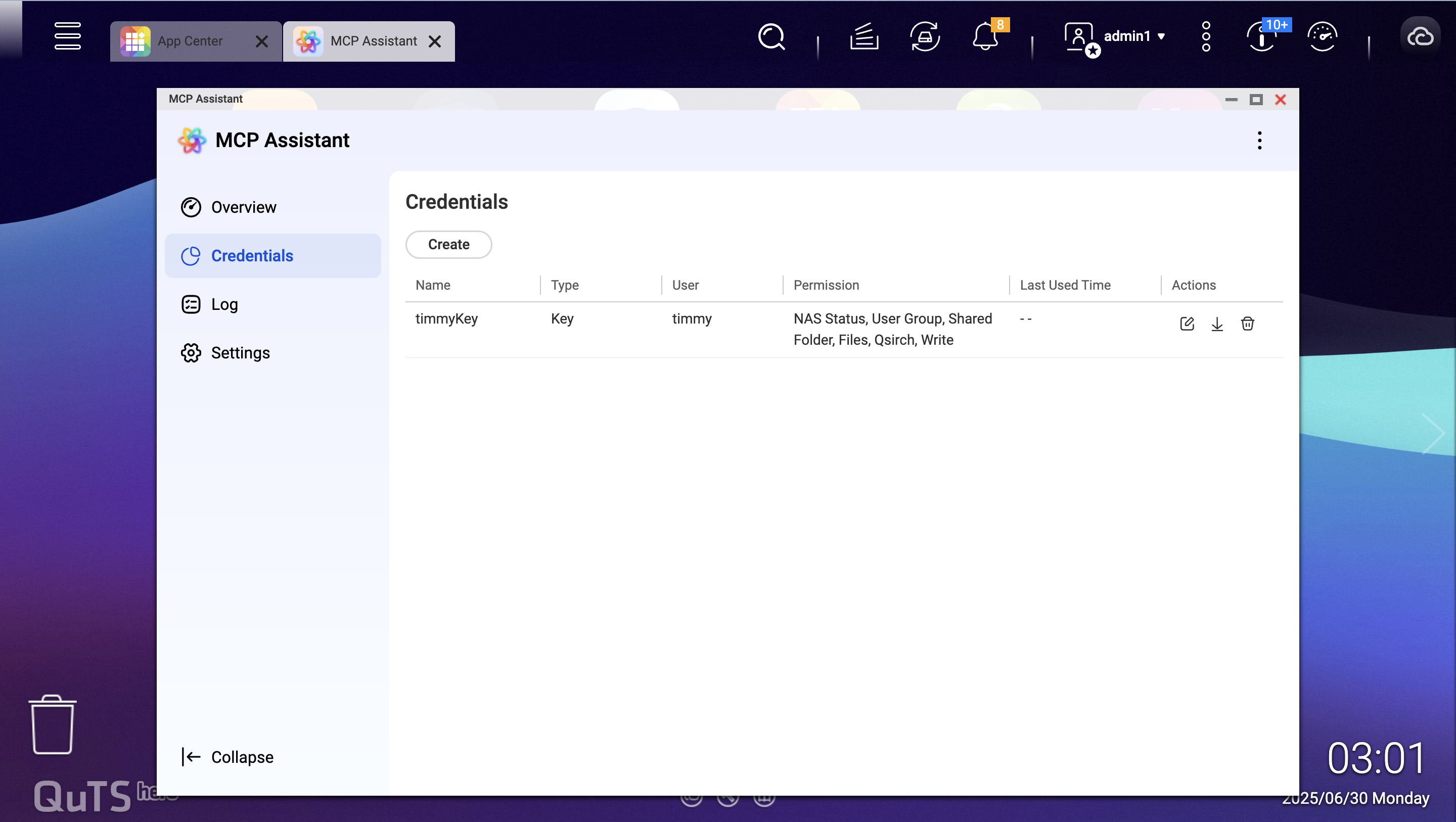
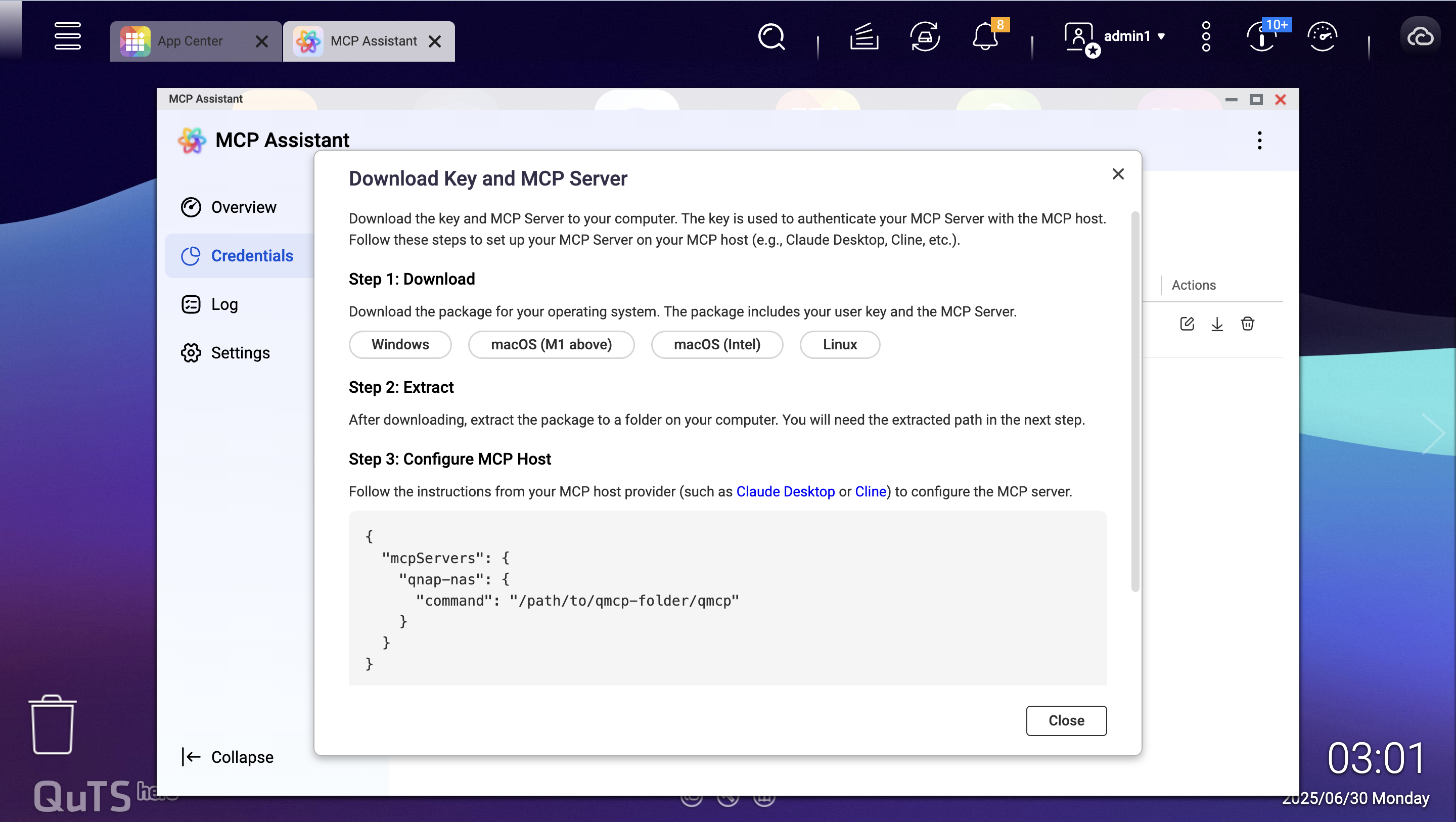
- Select your operating system:
- Windows – For Windows-based computers
- macOS (M1 and above) – For Apple Silicon Macs
- macOS (Intel) – For Intel-based Macs
- Linux – Claude Desktop is not available for Linux; use other MCP hosts.
- Click the button matching your OS to download the package, which includes both your user key and the MCP Server files.
- Extract the MCP Server ZIP package.
- Locate the downloaded file:
- The filename will vary (e.g., qmcp-darwin-arm64-250630_1502.zip).
- Check your Downloads folder or the location you selected.
- Extract the ZIP file:
- Windows: Right-click the ZIP file and select Extract All or use your preferred extraction tool.
- macOS: Double-click the ZIP file to extract it automatically or use a tool like The Unarchiver.
- Verify extraction:
- You should see a folder containing the MCP Server executable and configuration files.
- Note the folder path; you will need it for Claude Desktop configuration.
Important
Keep track of the extracted folder location for later configuration steps.
- Download Claude Desktop.
- Visit the official Anthropic website at claude.ai.
- Navigate to the Claude Desktop download section.
- Download the appropriate installer for your operating system:
- Windows: Download the .exe installer.
- macOS: Download the .dmg installer.
- Install Claude Desktop.
- Windows:
- Run the downloaded .exe installer.
- Follow the installation wizard prompts and accept the license agreement.
- Choose the installation location and complete the process.
- macOS:
- Open the downloaded .dmg file.
- Drag Claude Desktop to the Applications folder.
- If prompted, go to System Preferences > Security & Privacy and allow the application to run.
- Open Claude Desktop.
- Launch Claude Desktop from your desktop shortcut.
- If this is your first time launching Claude:
- Sign in with your Anthropic account.
- Complete any initial setup procedures.
- Accept terms of service if prompted.
Edit the configuration of Claude Desktop.
- Locate the configuration file:
- Use Claude Desktop UI: Menu (top left) > Settings > Developer > Edit Config.
- You may also find the configuration file here:
- Windows: %APPDATA%\Claude\claude_desktop_config.json
- macOS: ~/Library/Application Support/Claude/claude_desktop_config.json
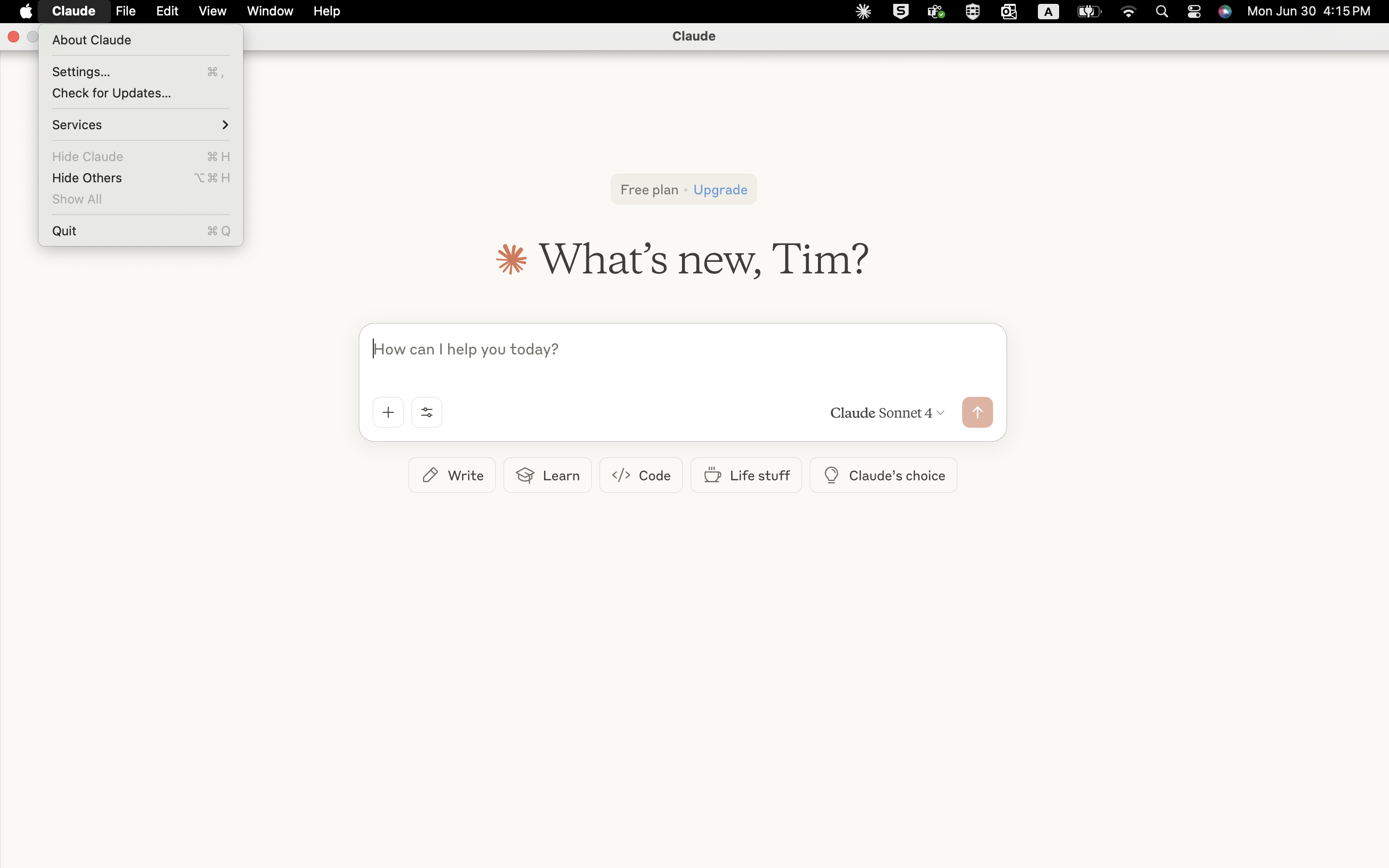
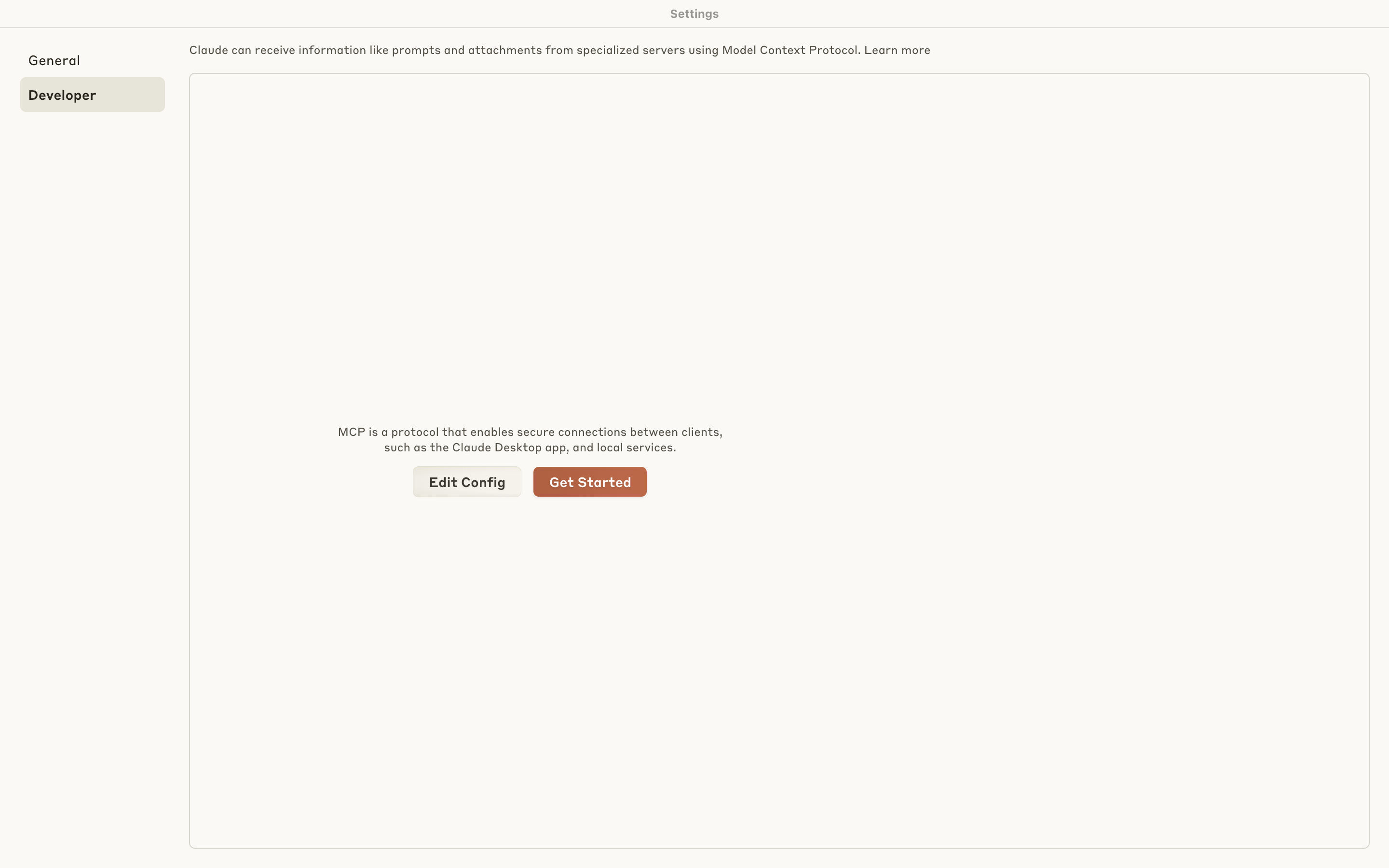
Edit the file:
- Open in a text editor (e.g., Notepad++, VS Code, TextEdit).
Add the MCP Server configuration as shown in the MCP Assistant dialog. For example:
{
"mcpServers": {
"qnap-nas": {
"command": "/path/to/qmcp-folder/qmcp"
}
}
}
Replace /path/to/qmcp-folder/qmcp with the actual path to your extracted MCP Server executable.
- On Windows, use double backslashes (\\) instead of single backslashes (\). For example:
C:\\Users\\YourName\\Downloads\\qmcp-folder\\qmcp.exe.
Save the configuration file.
Allow execution of the MCP Server.
- macOS users:
- You may see a security warning when running the MCP Server executable. Click Done to close the warning.
- Go to Apple Menu > System Settings > Privacy & Security > Security.
- Click Allow Anyway next to the blocked qmcp executable.
- Only allow executables from trusted sources to avoid risks.
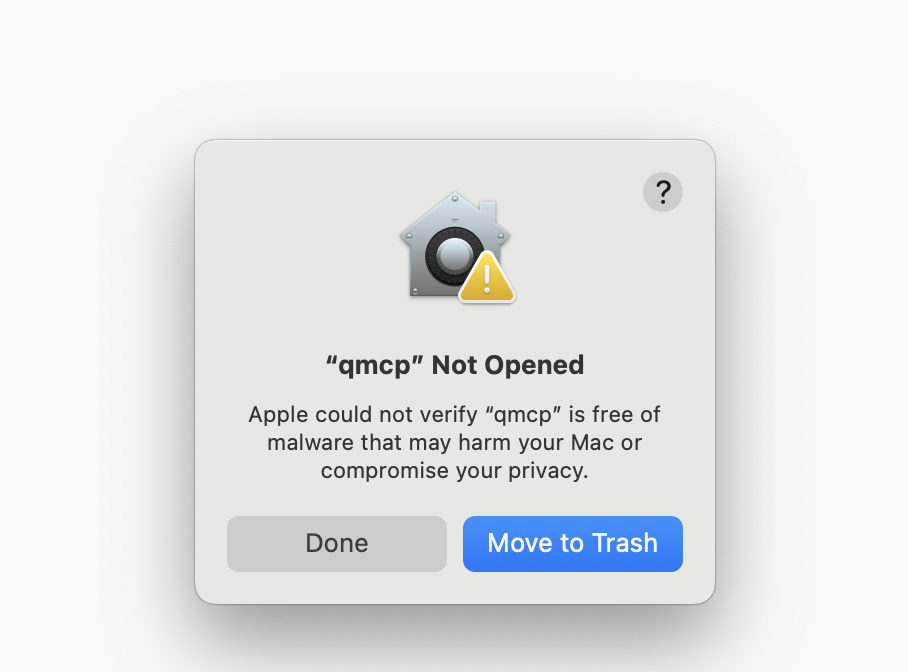
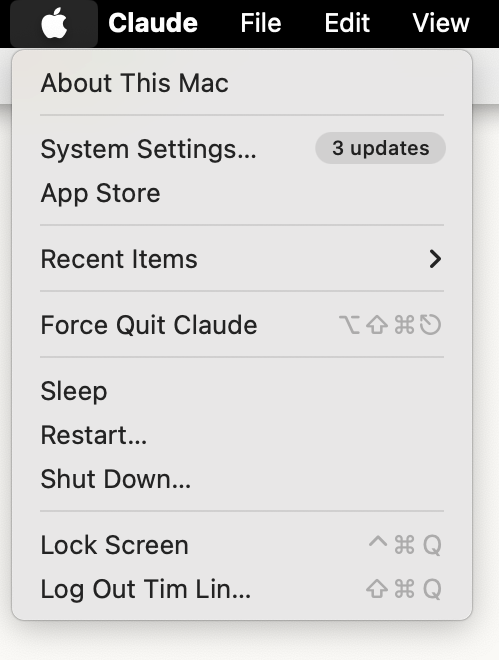

- Windows users:
- Ensure antivirus or firewall software does not block the MCP Server executable.
- Add exceptions if necessary.
- Re-open Claude Desktop and test the setup.
- To load your previous configuration, completely quit Claude Desktop and reopen it.
- macOS: Force Quit the app or close the app in Activity Monitor.
- Windows: open Task Manager, locate the app, and select End task.
If this does not work, restart your computer.
- Test with prompts such as:
- Can you access my QNAP NAS?
- Show me the status of my NAS storage.
- List the files in my shared folders.
- Verify Claude responds with successful interactions related to your NAS.
- If errors appear, check the user interface for details.
Troubleshooting Tips
Below are tips for quickly troubleshooting common issues.
- Connection issues: Ensure that the MCP Server path in the configuration file is correct.
- Permission errors: Ensure that the MCP Server executable has appropriate permissions.
- Authentication problems: Ensure that the authentication key from MCP Assistant is in the correct location.
- Firewall blocking: Ensure that your firewall allows MCP Server communication.
Conclusion
You have successfully set up QNAP MCP Assistant with Claude Desktop. You can now leverage Claude's AI capabilities to interact with your QNAP NAS through natural language commands, including file management and system monitoring.
QNAP MCP Assistant을 Claude Desktop과 함께 설정하는 방법은 무엇입니까?적용되는 제품
- QTS 5.2, QuTS hero h5.2 또는 이후 버전을 실행하는 QNAP NAS 장치
- MCP Assistant
소개
이 튜토리얼은 QNAP NAS와 Claude의 AI 기능 간의 원활한 통합을 가능하게 하는 Claude Desktop과 함께 QNAP의 MCP Assistant를 설정하는 과정을 안내합니다. 그런 다음 자연어 명령을 사용하여 NAS를 운영할 수 있습니다.
필수 조건
시작하기 전에 다음 설정을 확인하십시오:
- QTS 5.2, QuTS hero h5.2 또는 이후 버전을 실행하는 QNAP NAS 장치
- 인터넷 연결이 가능한 컴퓨터(Windows 또는 macOS; Claude Desktop은 Linux에서 사용할 수 없음)
- QNAP NAS에 대한관리자액세스
- 기본 MCP Assistant 포트: 8442 및 8443
절차
- App Center에서 MCP Assistant(베타)를 설치합니다.
- NAS가 QTS/QuTS hero 5.2.1 이상 버전을 실행하는 경우:
- QNAP NAS에 로그인합니다.
- 로 이동합니다App Center.
- 오른쪽 위 모서리에서 클릭합니다

- 선택QNAP 앱 베타 프로그램에 가입합니다 그리고 클릭합니다 적용.
- 검색 창에서 검색합니다MCP Assistant.
- 클릭합니다설치.
- NAS가 QTS/QuTS hero 5.2.0을 실행하는 경우:
- App Center의 웹페이지로 이동합니다.
- 검색합니다MCP Assistant.
- 클릭합니다MCP Assistant검색 결과에서.
- NAS 모델을 선택합니다.
- 설치 파일을 다운로드합니다.
- QNAP NAS에 로그인합니다.
- App Center로 이동합니다.
- 오른쪽 위 모서리에서 클릭합니다

- 선택수동으로 설치합니다.
- 클릭합니다Browse(찾아보기)QNAP 웹사이트에서 방금 다운로드한 설치 파일을 업로드합니다.
- 클릭합니다.설치합니다.
- MCP Assistant을 엽니다.
- 메인 메뉴에서 MCP Assistant을 찾습니다.
- MCP Assistant을 실행합니다.

- 자격 증명을 생성하고 MCP Server를 다운로드합니다.
- MCP Assistant에서자격 증명탭으로 이동합니다.
- 클릭합니다.생성새 키를 생성합니다.
- 키에 대한 설명 이름을 입력하고 키 유형을 선택한 후 이 키와 연결할 사용자 계정을 선택합니다.
팁
기본적으로읽기 전용 모드가 활성화되어 있습니다. 신뢰할 수 있는 사용자에게 더 많은 권한을 부여하려면 이 옵션의 선택을 해제할 수 있습니다.
- 사용자가 액세스할 수 있는 MCP 도구를 지정합니다.
- 클릭합니다.생성키 생성을 완료합니다.
- 키가 생성된 후에는작업 아래의 다운로드 화살표를 클릭합니다.
- 키 및 MCP Server 다운로드대화 상자가 나타나며, 인증 키와 MCP Server 파일을 컴퓨터에 다운로드할 수 있습니다.



- 운영 체제를 선택합니다:
- Windows– Windows 기반 컴퓨터용
- macOS (M1 이상)– Apple Silicon Macs용
- macOS (Intel)– Intel 기반 Macs용
- Linux– Claude Desktop은 Linux에서 사용할 수 없으며 다른 MCP 호스트를 사용하십시오.
- 운영 체제에 맞는 버튼을 클릭하여 패키지를 다운로드합니다. 이 패키지에는 사용자 키와 MCP Server 파일이 모두 포함되어 있습니다.
- MCP Server ZIP 패키지를 추출합니다.
- 다운로드한 파일을 찾습니다:
- 파일 이름은 다양할 수 있습니다(예: qmcp-darwin-arm64-250630_1502.zip).
- Downloads 폴더 또는 선택한 위치를 확인합니다.
- ZIP 파일을 추출합니다:
- Windows:ZIP 파일을 마우스 오른쪽 버튼으로 클릭하고모두 추출또는 선호하는 추출 도구를 사용합니다.
- macOS:ZIP 파일을 더블 클릭하여 자동으로 추출하거나 The Unarchiver와 같은 도구를 사용합니다.
- 추출 확인:
- MCP Server 실행 파일과 구성 파일이 포함된 폴더가 표시됩니다.
- 폴더 경로를 확인합니다. Claude Desktop 구성에 필요합니다.
중요
나중에 구성 단계에서 사용할 수 있도록 추출된 폴더 위치를 추적합니다.
- Claude Desktop을 다운로드합니다.
- 공식 Anthropic 웹사이트를 방문합니다claude.ai.
- Claude Desktop 다운로드 섹션으로 이동합니다.
- 운영 체제에 맞는 설치 관리자를 다운로드합니다:
- Windows: .exe 설치 관리자를 다운로드합니다.
- macOS: .dmg 설치 관리자를 다운로드합니다.
- Claude Desktop을 설치합니다.
- Windows:
- 다운로드한 .exe 설치 관리자를 실행합니다.
- 설치 마법사의 지침을 따르고라이선스계약을 수락합니다.
- 설치 위치를 선택하고 프로세스를 완료합니다.
- macOS:
- 다운로드한 .dmg 파일을 엽니다.
- Claude Desktop을 Applications 폴더로 드래그합니다.
- 메시지가 표시되면시스템 기본 설정 > 보안 및 개인정보로 이동합니다.애플리케이션 실행을 허용합니다.
- Claude Desktop을 엽니다.
- 바탕 화면 바로 가기에서 Claude Desktop을 실행합니다.
- Claude를 처음 실행하는 경우:
- Anthropic 계정으로 로그인합니다.
- 초기 설정 절차를 완료합니다.
- 메시지가 표시되면서비스 조건을(를) 수락합니다.
Claude Desktop의 구성을 편집합니다.
- 구성 파일을 찾습니다:
- Claude Desktop UI를 사용합니다:메뉴 (왼쪽 상단) > 설정 > 개발자 > 구성 편집.
- 구성 파일을 여기에서도 찾을 수 있습니다:
- Windows:%APPDATA%\Claude\claude_desktop_config.json
- macOS: ~/Library/Application Support/Claude/claude_desktop_config.json


파일을 편집합니다:
- 텍스트 편집기(예: Notepad++, VS Code, TextEdit)에서 엽니다.
MCP Assistant 대화 상자에 표시된 대로 MCP 서버 구성을 추가합니다. 예를 들어:
{
"mcpServers": {
"qnap-nas": {"command": "/path/to/qmcp-folder/qmcp"}
}
}
다음으로 대체 /path/to/qmcp-folder/qmcp 추출된 MCP 서버 실행 파일의 실제 경로로 대체합니다.
- Windows에서는 단일 백슬래시(\) 대신 이중 백슬래시(\\)를 사용합니다. 예를 들어:
C:\\Users\\YourName\\Downloads\\qmcp-folder\\qmcp.exe.
구성 파일을 저장합니다.
MCP 서버 실행을 허용합니다.
- macOS 사용자:
- MCP 서버 실행 파일을 실행할 때 보안 경고가 표시될 수 있습니다. 클릭합니다완료경고를 닫습니다.
- 이동합니다Apple메뉴 > 시스템 설정 > 개인 정보 및 보안 > 보안.
- 클릭어쨌든 허용차단된 qmcp 실행 파일 옆에.
- 위험을 피하기 위해 신뢰할 수 있는 출처의 실행 파일만 허용합니다.



- Windows 사용자:
- 바이러스 백신 또는방화벽소프트웨어가 MCP 서버 실행 파일을 차단하지 않도록 합니다.
- 필요한 경우 예외를 추가합니다.
- Claude Desktop을 다시 열고 설정을 테스트합니다.
- 이전 구성을 로드하려면 Claude Desktop을 완전히 종료하고 다시 엽니다.
- macOS: 앱을 강제 종료하거나 활동 모니터에서 앱을 닫습니다.
- Windows: 작업 관리자를 열고 앱을 찾아 선택합니다.작업 종료.
이 방법이 작동하지 않으면 컴퓨터를 다시 시작합니다.
- 다음과 같은 프롬프트로 테스트합니다:
- 내 QNAP NAS에 액세스할 수 있습니까?
- 내 NAS 스토리지의 상태를 보여주세요.
- 내 공유 폴더의 파일 목록을 보여주세요.
- Claude가 NAS와 관련된 성공적인 상호작용을 응답하는지 확인합니다.
- 오류가 나타나면 사용자 인터페이스에서 세부 정보를 확인합니다.
문제 해결 팁
아래는 일반적인 문제를 빠르게 해결하기 위한 팁입니다.
- 연결 문제:구성 파일에서 MCP 서버 경로가 올바른지 확인합니다.
- 권한 오류:MCP 서버 실행 파일에 적절한 권한이 있는지 확인합니다.
- 인증 문제:MCP Assistant의 인증 키가 올바른 위치에 있는지 확인합니다.
- 방화벽차단: 귀하의방화벽가 MCP 서버 통신을 허용하는지 확인합니다.
결론
QNAP MCP Assistant를 Claude Desktop과 성공적으로 설정했습니다. 이제 Claude의 AI 기능을 활용하여 자연어 명령을 통해 QNAP NAS와 상호작용할 수 있으며, 파일 관리 및 시스템 모니터링을 포함합니다.
















